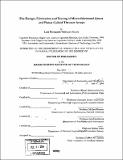| dc.contributor.advisor | Manuel Martínez-Sánchez. | en_US |
| dc.contributor.author | Velásquez García, Luis Fernando, 1976- | en_US |
| dc.contributor.other | Massachusetts Institute of Technology. Dept. of Aeronautics and Astronautics. | en_US |
| dc.date.accessioned | 2005-06-02T18:51:02Z | |
| dc.date.available | 2005-06-02T18:51:02Z | |
| dc.date.copyright | 2004 | en_US |
| dc.date.issued | 2004 | en_US |
| dc.identifier.uri | http://hdl.handle.net/1721.1/17832 | |
| dc.description | Thesis (Ph. D.)--Massachusetts Institute of Technology, Dept. of Aeronautics and Astronautics, 2004. | en_US |
| dc.description | Includes bibliographical references (p. 265-270). | en_US |
| dc.description.abstract | New space applications such as orbital control of micro-satellites and precise interferometry have created a demand for high precision, low thrust efficient space engines. Electrospray propulsion is a serious candidate for this new technological niche. Electrospray thrusters are space propulsion electric engines that take advantage of an electro-hydrodynamic effect known as Taylor cone to produce thrust. When this effect takes place, charged particles are expelled from the apex of a conductive liquid meniscus deformed into a conical shape; this shape results from the equilibrium between surface tension effects and electrostatic pulling on the meniscus surface. Electrospray thrusters are well suited for scaling down and batch production because these engines do not require large pressure ratios to achieve high efficiency, or high temperatures or plasma phase ionization to operate. Electro-spray thrusters can deliver thrust in a very precise way. Furthermore, they are able to match the requirements of any conceivable mission that any of the other space propulsion electro-magnetic engines can achieve because it is possible to use the same engine and propellant to span a wide range of Isp's and thrusts. This capability is due to the series of different regimes that the emitters could operate in (droplet emission, solvated ions and mixed regime). The present work tackles the problem of how to fabricate a colloid engine with large emitter density using micro-fabrication techniques, and demonstrates that highly packed colloid thruster arrays are feasible. The work is centered on two engine concepts: an internally fed linear colloid thruster array (with highly doped formamide as propellant-intended to work in the droplet emission regime), and two | en_US |
| dc.description.abstract | (cont.) variations of an externally fed planar electrospray thruster array (with the ionic liquid EMI-BF₄ as propellant-intended to work in the solvated ion emission regime). For the case of the linear colloid thruster array, it was possible to demonstrate cumulative emission uniformity and steady-uniform operation of the modular units (set of emitters fed by the same manifold), using the imprints of the exit stream on a collector. Both results are in agreement with theoretical models. Current versus flowrate dependence in agreement with the theoretical model of single Taylor cone-droplet emission was also demonstrated. It was experimentally found that he propellant doping level strongly influences its wettability with respect to the engine internal surface. As a consequence of this effect, engines that were brought to steady emission showed arcing because of bursting events during operation. The proposed electrical flow control was experimentally verified. In the case of the planar electrospray thruster array, uniform-steady emission was demonstrated for two types of emitter geometries using experimental impact traces on a collector and current versus voltage measurements. It was also shown that there is a strong dependence of the emitted current on temperature. Contributions of this work also include several novel fabrication techniques, particularly a process to generate black silicon using a chlorine-based plasma, a process to generate mesoscale uniform etching for silicon, a technique to anisotropically pattern thick silicon oxide films ... | en_US |
| dc.description.statementofresponsibility | by Luis Fernando Velásquez García. | en_US |
| dc.format.extent | 270 p. | en_US |
| dc.format.extent | 19341644 bytes | |
| dc.format.extent | 19372325 bytes | |
| dc.format.mimetype | application/pdf | |
| dc.format.mimetype | application/pdf | |
| dc.language.iso | eng | en_US |
| dc.publisher | Massachusetts Institute of Technology | en_US |
| dc.rights | M.I.T. theses are protected by copyright. They may be viewed from this source for any purpose, but reproduction or distribution in any format is prohibited without written permission. See provided URL for inquiries about permission. | en_US |
| dc.rights.uri | http://dspace.mit.edu/handle/1721.1/7582 | |
| dc.subject | Aeronautics and Astronautics. | en_US |
| dc.title | The design, fabrication and testing of micro-fabricated linear and planar colloid thruster arrays | en_US |
| dc.type | Thesis | en_US |
| dc.description.degree | Ph.D. | en_US |
| dc.contributor.department | Massachusetts Institute of Technology. Department of Aeronautics and Astronautics | |
| dc.identifier.oclc | 56569892 | en_US |
